Senseonics tips 365-day CGM to double 2025 sales by Nick Paul Taylor for MedTechDive.com, 25 June 2024.
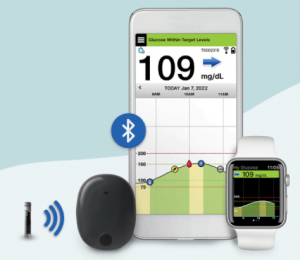 In 2024, Senseonics expects to more than double U.S. new patient starts and increase the global installed base by around 50%. The growth is built on the current 180-day version of Senseonics’ implantable Eversense CGM. Senseoonics plans to launch a 365-day sensor in the U.S. in the fourth quarter.
In 2024, Senseonics expects to more than double U.S. new patient starts and increase the global installed base by around 50%. The growth is built on the current 180-day version of Senseonics’ implantable Eversense CGM. Senseoonics plans to launch a 365-day sensor in the U.S. in the fourth quarter.
Brian Hansen, president of CGM at Ascensia Diabetes Care, Senseonics’ commercial partner, said that “the duration tests out very well” in consumer research, but the reduction in calibration frequency is the most attractive feature for users. Eversense’s 180-day sensor can need calibrating twice a day, something Senseonics CEO Tim Goodnow said “has been a competitive disadvantage.” Users calibrate the 365-day sensor once a week.
By reducing the frequency of calibration, Senseonics forecasts it can increase its global base from 6,000 users in 2024 to 12,000 users in 2025. Growing the user base could help efforts to integrate the CGM with other devices, said Hansen, who was chief commercial officer at insulin pump manufacturer Tandem Diabetes Care before joining Ascensia.
Read more: Senseonics tips 365-day CGM to double 2025 sales
What is EPI? DIY diabetes pioneer Dana Lewis wants you to know your risk by Dana Lewis with Stacey Simms for Diabetes-Connections.com,
 DIY Pioneer Dana Lewis was diagnosed with something called EPI – exocrine pancreatic insufficiency a couple of years ago. She’d never heard of it and was shocked to find out diabetes is considered a common co-condition. In fact, 20-30 percent of people with diabetes can end up with EPI. EPI can cause a lot of discomfort and stomach issues – and health issues if left untreated. Of course, Dana jumped in, publishing a review of studies and now- creating studies of her own. She’ll explain what she’s doing, why she needs your help, and more about this condition that doesn’t get much attention.
DIY Pioneer Dana Lewis was diagnosed with something called EPI – exocrine pancreatic insufficiency a couple of years ago. She’d never heard of it and was shocked to find out diabetes is considered a common co-condition. In fact, 20-30 percent of people with diabetes can end up with EPI. EPI can cause a lot of discomfort and stomach issues – and health issues if left untreated. Of course, Dana jumped in, publishing a review of studies and now- creating studies of her own. She’ll explain what she’s doing, why she needs your help, and more about this condition that doesn’t get much attention.
This is SUCH AN IMPORTANT ISSUE … and one that most people do not like to talk about. But there are solutions that make your life vastly improved, even with EPI!
Listen to the Podcast: What is EPI? DIY diabetes pioneer Dana Lewis wants you to know your risk
Your Apple Watch or Fitbit may be a breeding ground for E. coli and staph bacteria by Jordyn Bradley for Fortune.com/Well, 26 June 2024.
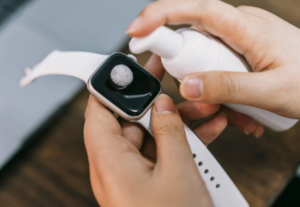 Experts say it’s not surprising that our Apple Watches, Fitbits, Garmins, and other activity trackers can cause skin irritation and infection, as we wear them while working out, showering, sleeping, and during other everyday tasks and likely don’t clean them as often as we should.
Experts say it’s not surprising that our Apple Watches, Fitbits, Garmins, and other activity trackers can cause skin irritation and infection, as we wear them while working out, showering, sleeping, and during other everyday tasks and likely don’t clean them as often as we should.
A 2023 study published in the journal Advances in Infectious Diseases examined 20 different smartwatch and fitness tracker bands and found that 95% were contaminated with infection-causing bacteria. Researchers found that 85% of the trackers tested had Staphylococcus aureus (Staph aureus), 60% had E. coli, and 30% had P. aeruginosa bacteria present. Simply put, they were carrying bacteria that can cause harmful infections in the bloodstream, bones, joints, and GI tract.
“Even at relatively low numbers these pathogens are of public health significance,” said Nwadiuto Esiobu, PhD., senior author and a professor of biological sciences in the Charles E. Schmidt College of Science at Florida Atlantic University. “The quantity and taxonomy of bacteria we found on the wristbands show that there is a need for regular sanitation of these surfaces.”
You can reduce your exposure to bacteria with simple cleaning measures.
-
-
-
- Clean the band with common household disinfectants regularly: The study found that Lysol disinfectant spray, 70% ethyl alcohol, and apple cider vinegar proved to be at least somewhat effective on all fitness tracker band materials.
- Follow the manufacturer’s instructions for cleaning the hardware: Companies like Garmin, Apple, and Fitbit list their specific cleaning and care recommendations on their sites.
- Use a damp microfiber cloth to clean your watch or tracker face: Microfiber is lint-free and won’t scratch your screen.
- Allow your skin to breathe: Apple Watch’s wear guide recommends wearing the watch tighter while working out (so sensors can work properly to track things like heart rate) and loosening it after your workout is complete.
-
-
Read more: Your Apple Watch or Fitbit may be a breeding ground for E. coli and staph bacteria
Low-Dose SGLT2 Inhibitor May Protect Kidneys in Youth With T1D by Kristen Monaco for MedPageToday.com, 25 June 2024.
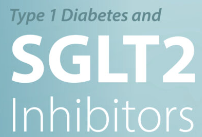 Adding a low dose of an SGLT2 inhibitor to insulin improved renal function and glycemic control in adolescents with type 1 diabetes (T1D), the late-breaking ATTEMPT trial found.
Adding a low dose of an SGLT2 inhibitor to insulin improved renal function and glycemic control in adolescents with type 1 diabetes (T1D), the late-breaking ATTEMPT trial found.
In the 98-patient study, treatment with a 5-mg dose of oral dapagliflozin (Farxiga) showed a renal-protective effect versus placebo, leading to a significant attenuation in glomerular filtration rate (GFR), the “gold standard” for measuring kidney function, said Farid Mahmud, MD, of the University of Toronto in Canada.
“These were not estimates of glomerular filtration,” he said during his presentation at the American Diabetes Association (ADA) annual meeting. “These were direct measurements … which are more invasive but they are far more accurate to assess kidney function.”
Read more: Low-Dose SGLT2 Inhibitor May Protect Kidneys in Youth With T1D
Novel GLP-1/Glucagon Drug Promising for Weight Loss by Crystal Phend for MedpageToday.com, 24 June 2024.
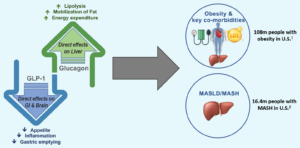 Novel dual GLP-1 and glucagon agonist pemvidutide reduced weight and lipids with somewhat less muscle loss than expected, the phase II MOMENTUM trial showed. Weight lost over 48 weeks ranged in a dose-dependent manner from 10.3% with the 1.2 mg weekly dose to 15.6% with the 2.4 mg weekly dose (P<0.001 vs placebo for all), reported Louis Aronne, MD, of Weill Cornell Medicine in New York City.
Novel dual GLP-1 and glucagon agonist pemvidutide reduced weight and lipids with somewhat less muscle loss than expected, the phase II MOMENTUM trial showed. Weight lost over 48 weeks ranged in a dose-dependent manner from 10.3% with the 1.2 mg weekly dose to 15.6% with the 2.4 mg weekly dose (P<0.001 vs placebo for all), reported Louis Aronne, MD, of Weill Cornell Medicine in New York City.
And the mean 32.2 lb shed likely wasn’t the plateau level, as trajectory curves continued downward at the 48-week mark, he said at the American Diabetes Association (ADA) annual meeting. Pemvidutide reduced LDL cholesterol by 6.2% to 11.2% and triglycerides by 21.7% to 34.9%, all statistically significant differences from placebo.
Pemvidutide was designed with a dual target to impact the gastrointestinal (GI) system and brain via GLP-1 to reduce appetite, inflammation, and gastric emptying as well as have direct impacts on the liver via glucagon to increase lipolysis, fat mobilization, and energy expenditure, Aronne said.
Robert Gabbay, MD, PhD, of the Joslin Diabetes Center in Boston and chief scientific and medical officer of the ADA said, “If two hormones are good, maybe two different hormones, maybe three hormones, and there’s one preclinical of four different hormones, and maybe we can make it into a pill and maybe we can do it as a monthly injection — almost every permutation you can think of,” which may help in targeting different patient populations. “After many years in the desert, [we’re] finally having some effective therapies that can really make a significant impact.”
Read more: Novel GLP-1/Glucagon Drug Promising for Weight Loss
How Do GLP-1 Receptor Agonists, Like Ozempic or Mounjaro, Work? by Catherine Rivera for EndocrinologyAdvisor.com, 14 June 2024.
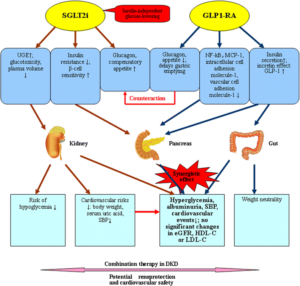 Glucagon-like peptide-1 (GLP-1) is a hormone released when food is eaten to slow gastric emptying, the process by which food leaves the stomach so that the body can absorb nutrients from food. It also increases insulin release from the pancreas and controls the feeling of satiety after eating.
Glucagon-like peptide-1 (GLP-1) is a hormone released when food is eaten to slow gastric emptying, the process by which food leaves the stomach so that the body can absorb nutrients from food. It also increases insulin release from the pancreas and controls the feeling of satiety after eating.
Insulin is a hormone produced by the pancreas that regulates the amount of glucose in the blood. When food is eaten, blood sugar increases, thus signaling the incretin system to release insulin. In some conditions, such as obesity and diabetes, the body does not respond to nutrients properly, which leads to the incretin system not functioning correctly and an increase in blood sugar.
GLP-1 receptor agonists activate the GLP-1 receptors located in the hypothalamus in the brain, which regulates food intake. By activating these receptors, GLP-1 receptor agonists decrease the feeling of hunger and cause the patient to eat less. GLP-1 receptor agonists also bind to the GLP-1 receptors on certain neurons in the brain to decrease hunger and increase satiety. They have been shown to slow gastric emptying within the first hour of eating, resulting in the feeling of being full. Patients who use GLP-1 receptor agonists experience reduced appetite and hunger, lower preference for high-calorie foods, decrease in food cravings, and better overall control of their eating habits.
Fact Sheet:
Read more: How Do GLP-1 Receptor Agonists, Like Ozempic or Mounjaro, Work?


I started Jardiance for Kidney protection. at the request of my nephrologist. I love it. My insulin load dropped by 1/3 and I have never felt better. I never dreamed it might work so good.
A gross watch? Well that makes for an unsettling thought.